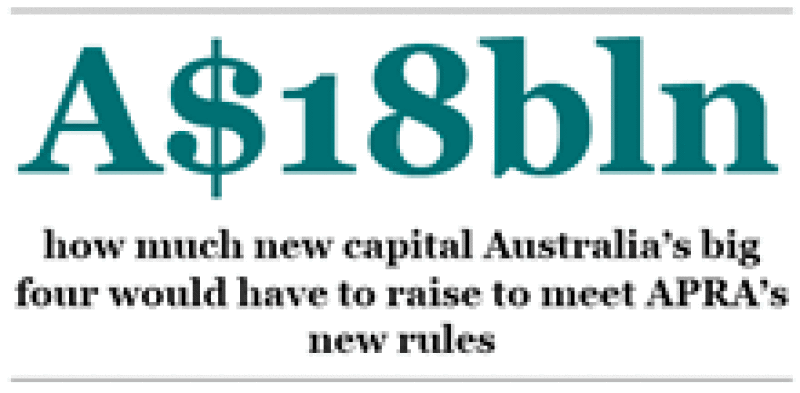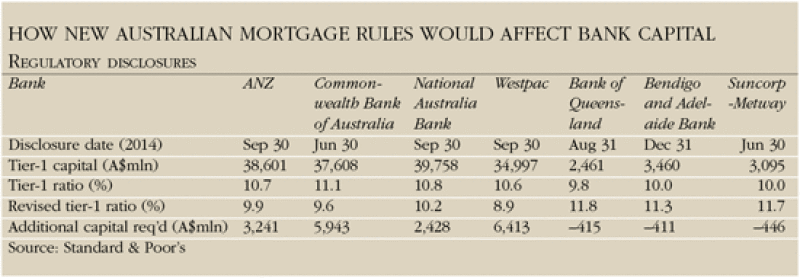Australia’s big four banks will need to raise A$18 billion ($13.8 billion) of new capital if the national banking regulator adopts a new recommendation, in a move that may help the country’s second tier of banks.
The Financial System Inquiry, commissioned by the Australian Treasury and released for consultation at the end of 2014, recommends that the Australian Prudential Regulation Authority (APRA) uses higher average risk weightings for home lending.
The market has been digesting the recommendations ever since. Standard & Poor’s put out a detailed report in May suggesting that if APRA did implement the recommendation, the banks would need A$18 billion to maintain their tier-1 capital ratios at current levels.
While that’s a clear burden for Commonwealth Bank of Australia (whose former CEO David Murray chaired the inquiry), National Australia Bank, Westpac and ANZ, the main conclusion from S&P was about who stood to benefit: the second tier of banks such as Suncorp, Bendigo and Bank of Queensland.

|
Today, the big banks must hold an average risk weight of 18% of residential mortgages; the other banks must hold 39%. The inquiry recommended that APRA require an average risk weighting of 27.5%, which would go some way towards making a more even competitive environment. “The recommendation will have a positive impact by creating a more level competitive residential mortgage loans playing field between the major banks and the three regional banks,” says Lisa Barrett, credit analyst at S&P.
Thinking it through, if the big banks had to raise all that extra capital, APRA itself reckons that those banks would probably have to lift the standard variable rate on their mortgages by 23bp to maintain their existing return on equity, while regional banks could maintain pricing. Looking at interest rates in the market, that would in many cases make the big banks more expensive than the smaller ones.
“Under a scenario such as this, the major bank would have to reconsider its willingness and ability to grow its mortgage book at the current high rate of growth, based on the competitive pricing they have enjoyed to date,” S&P’s report says.
Banks would either have to accept that mortgages are not going to be as profitable as they used to be, or they would have to raise rates and hope the business stays with them rather than fleeing to smaller competitors.

|
The mortgage question fits into a broader sense that Australia’s regional banks are well positioned to stand up and be counted in the country’s big four-dominated banking system – as reflected by Euromoney’s unprecedented decision to name Suncorp the best bank in Australia this year.
With three of the big four facing questions over conduct, and the fourth (Westpac) underwhelming with its result, Australia’s regional banks are facing a brighter future than has been the case for some time.
Deutsche Bank analyst Karen Chidgey, for example, holds a buy recommendation on Suncorp.
Speaking of the bank’s Optimisation programme for growth and efficiency, she writes: “Optimisation program benefits increase the probability that Suncorp will be able to reach its 10% return-on-equity target next year and sustain this over the medium term.”
Elsewhere, Bank of Queensland reported a 14% increase in statutory profit after tax in the first half of 2015, and Victoria-based Bendigo and Adelaide Bank – the fifth largest in the country – reported a 10.9% increase in cash earnings in its first half. In comparison, Westpac’s cash earnings were up only 2% in its interim statement (prior to a derivative adjustment).
Scandal
While the biggest bank, Commonwealth Bank of Australia, continues to perform well, it has spent much of the last year mired in a scandal around its financial-planning division through which thousands of customers lost large amounts of money – sometimes their life savings – as a result of inappropriate advice given by planners at the bank.
ANZ has paid A$30 million of compensation to 8,500 clients after one of its product offerings – called Prime Access – was found to have charged customers for financial advice it did not give. And National Australia Bank fired a number of employees from its wealth division over misconduct concerns; its subsidiary Meritum was one of a number of institutions investigated by the securities regulator, ASIC, for its selling of complex financial products to ordinary investors.
